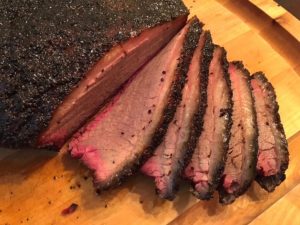All over the globe, meat is treated as a celebratory food. Meats like Thanksgiving turkey and honey-baked ham carry special meaning as they are symbolic for the gathering of people that they entail. Being from Texas, smoked meats are part of our heritage. These can range from ribs to sausage to pulled pork to brisket. All are cooked in a wood-burning smoker and the meats are seasoned with a basic rub of little more than salt and pepper. At all holidays and special events, this type of meat becomes the central point that Texans, and any others from the “barbeque belt”, gather around. In my house, Fourth of July, Memorial Day, and even sometimes Christmas involves smoked beef brisket as the main event on our dining table. My dad will plan out his days and wake up early the night before to put a brisket on our makeshift Big Green Egg smoker and monitor it over the next 12-14 hours. The end product is always crisp from the bark, juicy from the rendered fat, and has adeep penetrating smoke flavor
Smoked brisket has become my favorite dish not only because of its mouthwatering taste, but because of the good times that it represents with my family. As much as I would love to, this dish is not something that can be eaten every day. It takes hours to cook, is not exactly something for the health conscious, and it tends to be expensive when purchased from a restaurant. As a result, brisket has become synonymous with celebration and family gathering. As for its taste, I enjoy brisket because of its depth of meaty flavor that is so unique and not really replicated in other culture’s cuisine. If trimmed correctly before cooking, brisket should have all of its fat rendered into a moist piece of meat that takes on the flavor of the wood that it is smoked in.


Source: https://www.texasmonthly.com/bbq/faux-vide/
The earliest mention of brisket comes from a grocery store in 1910. This again emphasizes how brisket was, and still is, something to be cooked at home amongst family. Coming from the same part of the cow as Jewish Pastrami, brisket developed from the Jewish influence in the central Texas region. It wasn’t until the 1950s that brisket first appeared on the menu of Black’s BBQ in Lockhart, Texas. While brisket has spread in popularity across the country since then, it is still this central Texas region of Austin and Lockhart that is where the best is located. Restaurants like Franklin Barbecue, Kreutz Market, and Snows have become institutions, and their chefs are as famous as celebrities. The meticulousness of chef Aaron Franklin, and his dedication to perfecting the meat have led him to be known as the king of brisket. While brisket stems from this region of Texas, each part of the “barbecue belt” of the United States is known for their own take on southern barbeque. Memphis is known for dry rub ribs, the Carolinas for pulled pork, and Kansas City for burnt ends. Each of these places across the United States have pride in their product and have the same love for barbeque as I do for brisket.
Recipe for Texas Smoked Brisket
Source: https://putneyfarm.com/2013/09/14/bbq-brisket-franklin-style/
Ingredients:
- 1, 10-12 pound “full packer” brisket
- 1/2 cup salt
- 1/2 cup fresh ground pepper, finely ground
- Oak wood, chunks or chips, for smoking.
Assemble:
- Trim the fat layer on the “flat” section of the brisket to 1/4 inch. Trim all the thick, hard fat around the “point” section. Trim any super-thin sections of the meat that will burn during long-cooking.
- Mix the salt and pepper in a bowl and lightly cover all the brisket with salt and pepper. Keep mixing the salt and pepper as you go, to keep even distribution. Avoid clumps or spots of extra rub. You do not need to use all the rub. Set brisket aside.
- Set up your smoker to smoke at 225 to 250 F degrees (Franklin runs closer to 250 F). Add your wood and then add the brisket. Add water pans. Cook for 6 hours, adding wood as needed. Check the brisket (internal temp will probably be 130-150 F). Wrap the brisket in butcher paper or foil and cook another 5-7 hours (finish in the oven, if you like). Look for an internal temperature of about 195 F. Or see if all (both “flat” and “point”) of the meat is soft and “jiggles” to the touch. Remove from the heat and rest, in the paper or foil, 45-60 minutes.
- To serve, slice the “flat” section of the brisket, across the grain, in pencil-thin slices. The grain for the “point” section runs in the other direction. Rotate the “point” 90 degrees, cut it in half, and then serve in pencil-thin slices. Look for, and find, the grain before you slice.
- Serve with slaw, white bread and some sauce, if you like.

Hi, Tyler, I’m quite intrigued by your forceful opening statement that “all over the globe, meat is treated as a celebratory food”–I wonder if you’ve arrived at this conclusion by your research. If so, please provide the source(s) for this claim. I’m sure other readers are equally interested in knowing why. It’s actually quite refreshing to read about a favorite dish that is made purely of meat! Thanks for the delicious-looking photo of the brisket. You’ve provided your audience with very detailed descriptions of the familial practices surrounding the brisket. I’m glad that you find brisket “synonymous with celebration and family gathering”–I would encourage you to explore along these lines, but try to be more explicit about what your favorite dish does for you. Has your understanding of your regional culture, your family, and your identity changed over the years through your experience of brisket? After you began your studies at Emory, does your conception of your favorite dish stay the same? Any attempts at cooking smoked brisket away from home, with your friends?
Hi Wenwen, I took a previous Emory course called Food, Health, and Society, and we talked a lot about how different cultures used meat as a celebratory food. For example, in Brazil and other countries around the world, their Carnival celebration before starting lent involves eating large amounts of different meats. Specifically, the word Carnival comes from the latin expression Carne levare, or “to leave the meat”, so they overindulge on meat prior to sacrificing it during the season of lent. Here is a link to more information about it if you are curious. https://transpanish.biz/translation_blog/the-origin-of-the-word-carnival/